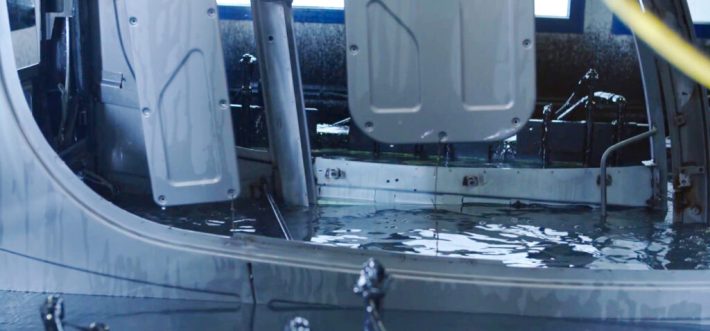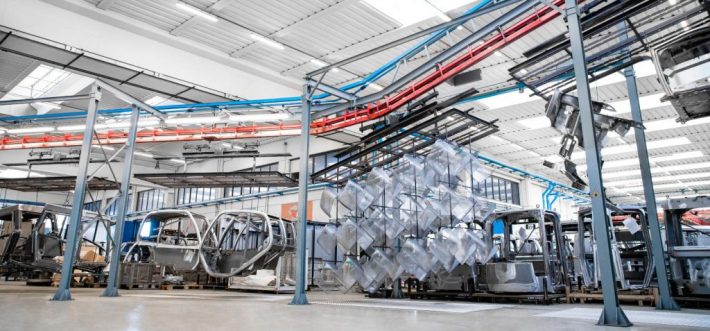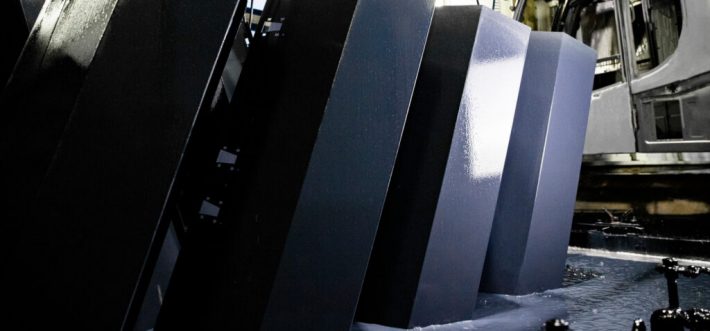Having spoken several times about the e-coating process, the time has come to go a little deeper with the matter, to explain in detail what it consists of from a more technical and specific point of view.
In these pages we have spoken and mentioned several times the E-coating treatment, its importance and why we recommend its use to improve the protection of articles from corrosion. It is one of the main treatments we can offer to our customers and our dedicated plant is among the largest in Europe.
Now the time has come to go a little deeper, to explain in detail what E-coating consists of from a more technical and specific point of view.
The chemical-physical principle behind E-coating
The phenomenon at the base of this process is called electrophoresis: introducing in a special tank two electrodes, between which is applied a potential difference, the particles of the colloid that make up the liquid contained in the tank are set in motion thanks to the electric field that is generated, directing all towards one of the two electrodes. In the case where the polarity is directed towards the cathode, we speak of the E-coating process (cataphoresis), in the case where it is directed towards the anode, we speak of the anaphoresis process (a practice now in disuse, surpassed by E-coating).
If this is the phenomenon that puts the particles in motion, there are others that take part in the laying of the coating: these are mechanical transport, electrolysis, electro-osmosis and electrocoagulation..
- Mechanical transport: this is guaranteed by the electrical charge supplied to the bath, which keeps the particles in agitation.
- Elettrolysis: is a process that leads to chemical transformations thanks to the contribution of electrical energy; thanks to this phenomenon the following reaction is carried out at the cathode (i.e. the piece to be painted): 4H2O + 4e- → 2H2 + 4OH-.
- Electro-osmosis: it consists of the migration of the liquid contained in the bath and in which the particles were previously present, outside the film placed on the coating; it is of great importance in the subsequent phase of rinsing the product because thanks to this process the percentage of liquid will be extremely low.
- Electrocoagulation: this is a key moment, in which the particles that make up the bath are deposited on the surface to be coated. To better control this phase it is necessary to find the right balance between timing, voltage, current, temperature, pH.

The phases that make up the E-coating treatment
We have seen the chemical and physical principles that drive this process, and now we are going to take a closer look at the phases that are carried out and defined within our facility, which boasts one of the largest E-coating plant in Europe. The entire process, which comprises 11 sequential phases, can be divided into three macro-steps – cleaning, pre-treatment and E-coating.
Before starting with the E-coating treatment, the articles must be adequately prepared, cleaned and prepared to receive the coating. This begins with the cleaning phase and specifically with the alkaline degreasing treatment. Here the articles are first immersed and then “rinsed” with an alkaline solution specifically designed to remove from the surface the oily or ferrous residues resulting from the carpentry activity that led to the creation of the raw material that will be treated. The moment dedicated to cleaning is then completed with several stages of rinsing with tap water, at the end of which the items can pass to pre-treatment.
The pre-treatment process is just as important, because it enables the articles to be prepared for the subsequent E-coating in the best possible conditions. This is where the phenomena of activation and phosphating of the zinc salts take place, the first step in protecting the article. Here, the zinc salt crystals are deposited on the surface of the metal parts to be treated, giving them an initial level of protection against corrosion and rust. This is followed by the fundamental steps of demi and passivation: with the first, through filters, the salts are removed from the raw water and through UV rays any bacteria that could corrupt the treatment are eliminated, while the second consists of an additional layer of protection that is applied over the pre-treatment described above.

At this point the article is ready to be treated by E-coating: as already mentioned, it is a coating applied by electrodeposition in an immersion tank composed of resin, pigments, charges and solvents, where a series of physical-chemical phenomena lead the coating to deposit itself on the substrate. Once out of the tank, the articles are rinsed with the ultrafiltrate: this is the liquid part of the bath, from which the pigmentation is subtracted, and which is extracted with a special instrumentation similar to those for reverse osmosis. Ultrafiltration allows a series of benefits such as the recovery of paint, the control of the chemical parameters of the bath, the maintenance of constant conductivity.
Now, after a further moment of rinsing, the articles are ready to enter the oven, which will definitively deposit and polymerize the paint.
Our plant is completely automated and remotely controlled by specialized technicians: this allows us to standardize production and organize it as needed.

Why choose E-coating
E-coating provides extreme protection against corrosion, external agents and chemical agents, for this reason, it is widely used in demanding sectors such as automotive, motorcycle, agricultural, industrial machinery, liquid handling, heating and refrigeration, furniture. These are sectors where the articles are often in contact with agents and substances that could corrupt the metal articles leading them to rust: E-coating does nothing but prevent this from happening, significantly lengthening the life cycle of the product and combining these characteristics with an optimal aesthetic appearance.
In addition to this benefit, note that it is the only process that guarantees complete coverage of the articles, even in the corners, edges and smallest cavities.

